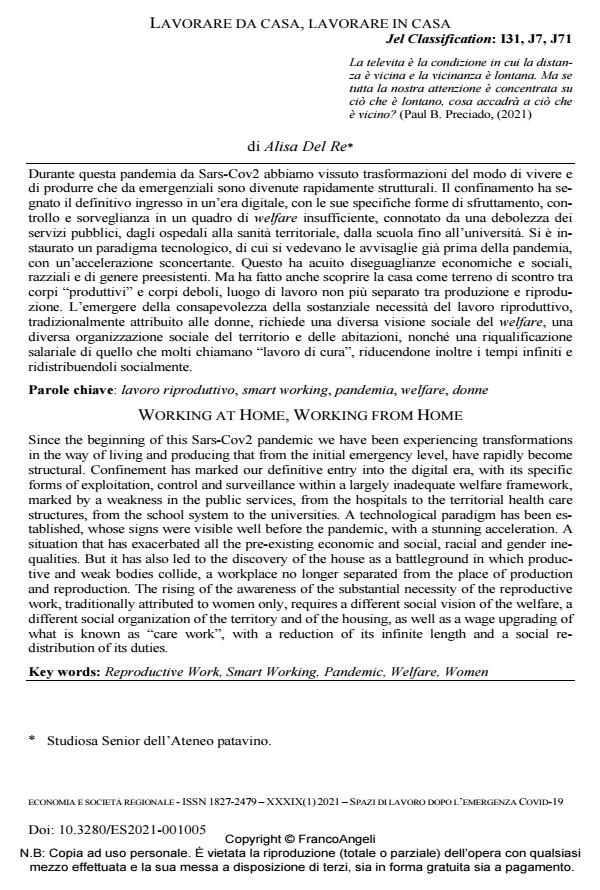Lavorare da casa, lavorare in casa
Journal title ECONOMIA E SOCIETÀ REGIONALE
Author/s Alisa Del Re
Publishing Year 2021 Issue 2021/1
Language Italian Pages 11 P. 55-65 File size 248 KB
DOI 10.3280/ES2021-001005
DOI is like a bar code for intellectual property: to have more infomation
click here
Below, you can see the article first page
If you want to buy this article in PDF format, you can do it, following the instructions to buy download credits

FrancoAngeli is member of Publishers International Linking Association, Inc (PILA), a not-for-profit association which run the CrossRef service enabling links to and from online scholarly content.
Since the beginning of this Sars-Cov2 pandemic we have been experiencing transformations in the way of living and producing that from the initial emergency level, have rapidly become structural. Confinement has marked our definitive entry into the digital era, with its specific forms of exploitation, control and surveillance within a largely inadequate welfare framework, marked by a weakness in the public services, from the hospitals to the territorial health care structures, from the school system to the universities. A technological paradigm has been es-tablished, whose signs were visible well before the pandemic, with a stunning acceleration. A situation that has exacerbated all the pre-existing economic and social, racial and gender ine-qualities. But it has also led to the discovery of the house as a battleground in which produc-tive and weak bodies collide, a workplace no longer separated from the place of production and reproduction. The rising of the awareness of the substantial necessity of the reproductive work, traditionally attributed to women only, requires a different social vision of the welfare, a different social organization of the territory and of the housing, as well as a wage upgrading of what is known as "care work", with a reduction of its infinite length and a social re-distribution of its duties.
Keywords: Reproductive Work, Smart Working, Pandemic, Welfare, Women
Jel codes: I31, J7, J71
- Smart work e gli stili di vita Davide Dazzi, in QUADERNI DI ECONOMIA DEL LAVORO 113/2022 pp.29
DOI: 10.3280/QUA2021-113003 - The variable geometry of bargaining: implementing unions' strategies on remote work in Italy Anne-Iris Romens, Valeria Piro, Francesco E. Iannuzzi, in STUDI ORGANIZZATIVI 1/2022 pp.129
DOI: 10.3280/SO2022-001006
Alisa Del Re, Lavorare da casa, lavorare in casa in "ECONOMIA E SOCIETÀ REGIONALE " 1/2021, pp 55-65, DOI: 10.3280/ES2021-001005